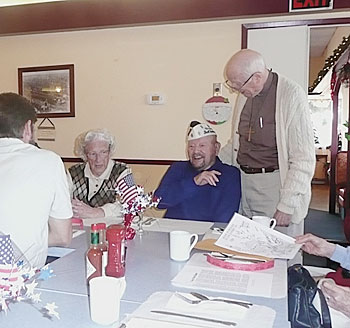By Edita McQuary
 In remembrance of what President Roosevelt called that “dastardly attack” 72 years ago on Sunday, December 7, 1941, on the US Naval Base at Pearl Harbor, Hawaii by the Japanese Empire, thirty-nine people gathered in Watsonville’s California Grill at 11 a.m. on Saturday, December 7, 2013, to honor three local survivors: James Ford, 93, Howard Trotno, 96, and Frank Myers, 93. Also there to share memories of that day were two people who had been children of navy personnel at Pearl Harbor, retired local teacher Esther Jessee, and Art Lee, retired navy commander of aircraft maintenance.
In remembrance of what President Roosevelt called that “dastardly attack” 72 years ago on Sunday, December 7, 1941, on the US Naval Base at Pearl Harbor, Hawaii by the Japanese Empire, thirty-nine people gathered in Watsonville’s California Grill at 11 a.m. on Saturday, December 7, 2013, to honor three local survivors: James Ford, 93, Howard Trotno, 96, and Frank Myers, 93. Also there to share memories of that day were two people who had been children of navy personnel at Pearl Harbor, retired local teacher Esther Jessee, and Art Lee, retired navy commander of aircraft maintenance.
Since 2009, the group’s master of ceremonies has been Rev. Glenn Johnson, a retired Santa Cruz Lutheran pastor. Pastor Johnson took over from long-time leader Rev. Eric Sorenson, when he could no longer participate. Pastor Sorenson had served on the USS Patterson, a destroyer escort that was at Pearl Harbor during the attack but survived undamaged. Ingrid Larson, Pastor Sorenson’s daughter, and her husband, Bill, an Air Force maintenance test pilot, were also present.
The program began with a call to order, the pledge of allegiance, and a popular song about Pearl Harbor during World War II:
 “Let’s remember Pearl Harbor, as we go to meet the foe,
“Let’s remember Pearl Harbor, as we go to meet the foe,
Let’s remember Pearl Harbor as we did the Alamo.
We will always remember how they died to set us free
Let’s remember Pearl Harbor and push on to victory!”
In remembrance of the 2400 individuals who gave their lives on that day, there was a moment of silence.
“Ships and Stations” introduced the three navy survivors.
James Ford served on the USS Argonne, which served as the flagship for Rear Admiral William L. Calhoun, Commander, Base Force, Pacific Fleet, a repair ship and troop transport. He and his wife, Ruth, came with son Jon, grandsons Shaun, Josh and Joel, great-grandson Skyler and two beautiful great granddaughters Amelia and Amiranthia. Amelia voiced her opinion that even though her “Grandpa was really old, he was the best grandpa that anybody ever had!”
 Howard Trotno served on the USS Hulbert, a destroyer converted to carry fuel. He and his fellow sailors were below-decks waiting for their breakfast when the attack started. He recalled saying, “The hell with the Japs, let’s eat our breakfast.” He and wife Edith have been married 68 years.
Howard Trotno served on the USS Hulbert, a destroyer converted to carry fuel. He and his fellow sailors were below-decks waiting for their breakfast when the attack started. He recalled saying, “The hell with the Japs, let’s eat our breakfast.” He and wife Edith have been married 68 years.
Frank Myers was stationed on the Battleship USS Maryland, which took two bombs but lost only two officers and two men in the attack. But they managed to shoot down at least two Japanese airplanes and took aboard many of the survivors of the Battleship Oklahoma. After repairs in Bremerton, WA, the Maryland saw action throughout the Pacific including Saipan and Okinawa.
Remembrances continued with Esther Jessee, who was five years old at the time, telling us her family had just been moved into Family Housing Area #1, two blocks from Hickam Field, and two blocks from Pearl Harbor. She and her brother heard, then saw airplanes but were not concerned until he saw the rising sun emblem on the plane and yelled, “Those are Jap planes!” Esther remembers seeing the face of a Japanese pilot grinning as he flew past after unloading his bombs.
 As it was a Sunday morning, little Esther thought she should go to Sunday school and started to walk down the street. Her mother hurried after her and brought her home. Later they heard that bombs had killed two women at the nearby tennis courts.
As it was a Sunday morning, little Esther thought she should go to Sunday school and started to walk down the street. Her mother hurried after her and brought her home. Later they heard that bombs had killed two women at the nearby tennis courts.
Esther’s family and others were evacuated to the YMCA. There were hundreds of cots and she remembers the sounds of crying and wailing — many husbands/fathers had been lost.
Another navy dependent survivor was Art Lee, then 13 years old, he was the son of Harry Lee, repair officer on the Battleship USS California, which, was badly damaged and sunk but later raised and repaired. Their house was situated on a hillside and Art saw a Japanese dive-bomber fly below their home.
Art comes from a long line of navy personnel, including his uncle, John Rutherford, who at the time was in charge of the Pearl Harbor ammunition depot. He recalls how the USS Pyro, an ammunition ship, was hit (“straddled” to use his word) – dropping bombs on each side. Luckily, one hit the water; the other went through the dock. Immediately, the USS Pyro fired back at the enemy and was credited with damaging one Japanese plane.
 Although not at Pearl Harbor, army veteran Ray Burgess was wounded in Europe at the Battle of the Bulge and awarded a half-dozen of medals for valor. He has been volunteering in schools teaching the kids about WWII. Joe Myers, like Ray, a Purple Heart and Bronze Star recipient, has been writing history for a local newspaper for some years.
Although not at Pearl Harbor, army veteran Ray Burgess was wounded in Europe at the Battle of the Bulge and awarded a half-dozen of medals for valor. He has been volunteering in schools teaching the kids about WWII. Joe Myers, like Ray, a Purple Heart and Bronze Star recipient, has been writing history for a local newspaper for some years.
There were many other stories including one related by an older lady who thanked the “greatest generation” for saving the world, particularly saving Germany from Hitler where she and her family lived at the time and were fortunate to be allowed to emigrate to the U.S. after the war.
The group meets four times each year on the first Saturday of March, June, September, and, of course, each December 7th. The national Pearl Harbor survivors group disbanded some time ago due to the members dying off. The Santa Cruz County and Monterey County group joined into the current “Pearl Harbor Survivors-at-Large.” Since 2009, the person in charge of communications has been Alice Weigel, who got interested in the group because of a friend who was the daughter of a survivor. She attended a meeting and was invited by Pastor Eric to get involved.
To end the event, Alice told us that a wonderful person by the name of Daniel Carrillo of Pajaro Valley Printing in Watsonville had picked up the tab for the whole group! Thank you, Daniel!
•••
Thank you to all the people who served in the military, their families, and thank you to all the many who helped with this article.

